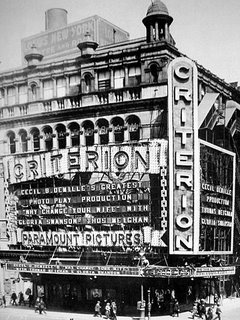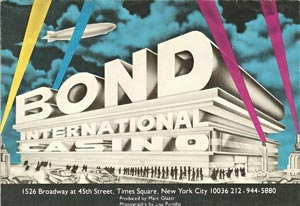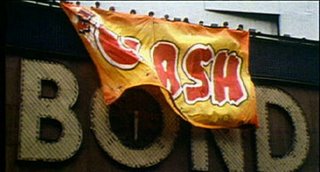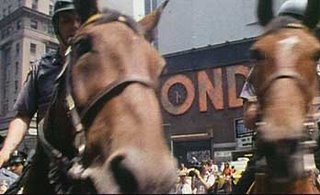Before the Times set up shop in the area, Longacre Square was the horse dung-scented center of New York's carriage trade. An unseemly spot indeed for the future Crossroads of the World, but as the city's entertainment districts had been inexorably migrating ever further uptown along Broadway throughout the 19th century, the Square's eventual colonization by the theater crowd was inevitable. Oscar Hammerstein I was the earliest impresario to venture there. In 1895, on the site of the former 71st Regiment Armory (destroyed in a fire), he opened the Olympia Theatre, a massive Beaux Arts complex comprising a 2,800-seat Music Hall, a 1,850-seat playhouse called the Lyric Theatre, a smaller Concert Hall, and a roof garden theater. According to Anthony Bianco's Ghosts of 42nd Street (New York: HarperCollins, 2004), admission was fifty cents, and patrons could wander between the theaters at will. "[T]he Olympia did not style itself as a family entertainment venue," writes Bianco. "Content to leave the middle of the road to others, Hammerstein experimented with provocative new acts and formats that expanded vaudeville's boundaries." Hammerstein's adventurous fare included operas (some of which were his own compositions), "Living Pictures" (tableaus presented partially in the nude), Isham's Octaroons (an African-American song-and-dance troupe), and a notoriously so-bad-they're-good act called the Cherry Sisters. Unfortunately, not every production he put on was a financial success, which led to a foreclosure on the property after only three years of operation. The building was auctioned off, and the theaters became separate entities under the auspices of different producers. Hammerstein's next local enterprises, the smaller-in-scale Victoria and Republic Theatres, were more lucrative. Meanwhile, the Music Hall was renamed the New York Theater, and was converted into a movie/vaudeville house when Loew's took it over in 1915. The Lyric was first renamed the Criterion, then became a movie house called the Vitagraph in 1914, only to revert to the Criterion moniker a couple of years later. In 1907, Flo Ziegfeld staged his first production of Follies at the rooftop garden theater, renamed Le Jardin de Paris. When he decamped for the New Amsterdam in 1913, the roof garden was converted into a dancehall called Jardin des Danses. Despite its many virtues, the magnificent Olympia building did not outlast the Depression; it was demolished in 1935.




A year later, the Criterion Building rose in its stead. It occupied the same block-long frontage, but was not nearly as tall as its predecessor--unless you include the height of its huge rooftop neon sign, a fish-festooned spectacular advertising Wrigley's Spearmint Gum.



The building featured a new Criterion movie house (designed by Thomas Lamb and Eugene de Rosa), ground-level retail space, and a fabulous Art Deco nightclub/restaurant called the International Casino. According to Susan Waggoner's Nightclub Nights: Art, Legend, and Style, 1920-1960 (New York: Rizzoli, 2001), this Casino had nothing to do with gambling:
Once one passed through the solid brass doors and into the red and gold mosaic lobby, there was no shortage of amusements. The Cosmopolitan Salon was fitted with a small stage and littered with settees that could accommodate nearly eight hundred. Another one hundred and sixty could quench their thirst at the Spiral Bar, a curved slide of polished mahogany that swept from the ground floor up to the mezzanine. All this was a mere warm-up for the main room, where tiered platforms assured all fifteen hundred diners an unobstructed view of the show.

The show, mounted on an elaborately high-tech motorized stage, featured such delights as "novelties from five continents and the beauties of ten countries," an orchestra "whose reed section might suddenly plunge from sight, like riders on a parachute drop," a fanciful "Ice Frolics" revue, comedians like Milton Berle, and gorgeous chorines with gams for days. The swank Streamline Moderne surroundings were "designed by Donald Deckie, who later designed the Radio City Music Hall," according to Anthony Haden-Guest's The Last Party (New York: William Morrow, 1997). However, the Casino may have been too gloriously grandiose for its own good; much like the Olympia, it closed after a mere three years in business.
Bond Clothes took over the Casino's space in 1940, moving from its previous location adjacent to the Palace Theater a couple of blocks north. In its new digs Bond styled itself as the world's largest men's haberdashery, and offered some women's wear as well. As if the store's famous "TWO TROUSER SUITS" neon sign weren't enough, beginning in 1948 it also boasted the most splendid spectacular ever to grace the Great White Way, designed by Douglas Leigh for Artkraft-Strauss. As described in Leigh's 1999 Times obituary:
At the base of the Bond sign was an electric news zipper, about five feet high, running along the entire facade. In Mr. Leigh's design, twin 50-foot-high figures, one male and one female, flanked a waterfall 27 feet high and 120 feet long. Strands of electric lights seemed to clothe the chunky classical figures at night, but by day they appeared naked.



Those loincloth-lights were added only after guests at the Hotel Astor across the street complained about the statues' scandalously starkers state. A clock poised above the waterfall perpetually reminded the public, "EVERY HOUR 3,490 PEOPLE BUY AT BOND." (I suppose an even 3,500 customers per hour would have been too much to handle...)

After six good-looking years, the sign was replaced with a Pepsi ad; the waterfall remained (and kept gushing until the early '60s), but was now flanked with giant Pepsi bottles. Apparently a Chevy ad was once meant to take Pepsi's place, but a garagantuan Gordon's Gin bottle and a smoking Winston man (a total Camel sign rip-off) eventually appeared there instead. The ground-level storefronts evolved over time as well--among the successive occupants were Woolworth's, Whelan Drugs, King of Slim's Ties, Loft's Candy, Regal Shoes, Disc-O-Mat Records, tourist tchotchke outlets, and those ubiquitous bad-deal '70s/'80s electronics stores.


Bond Clothes sold its last two-trouser suit in 1977, and after a couple of vacant years, the space was respectfully rechristened as Bond International Casino, supposedly the largest disco the world had yet seen. As described in The Last Party, the club was co-owned by John Addison and Maurice Brahms. It opened in July 1980, and featured such accoutrements as a "musical staircase," fountains retrieved from the set of The Liberace Show (which often ended up filled with near-naked patrons), and a wide-ranging music policy (usually spun by resident DJ Kenny Carpenter). However, according to these opinionated folks on discomusic.com, the joint never quite caught on, for various reasons--bad location (Times Square at the height of its sleazy-seedy era), poor acoustics, lack of an atmospheric theme, inconsisent musical choices, and above all, too much space to fill on a nightly basis.
There were no such space-filling difficulties during the Clash's booking in May-June, 1981. The buzz surrounding their initial eight-night stand was so high that the shows were dangerously oversold--3,500 tickets for each night, at a venue with a legal capacity of about 1,800. The FDNY threatened to shut the place down following the first two overcrowded nights. After much negotiation with city authorities, the band worked out a deal wherein they would play as many shows as it would take to honor all ticket holders--an unprecedented seventeen concerts. Times Square hadn't seen that much commotion since Frankie at the Paramount, or V-J Day. An incredibly and obsessively detailed day-by-day account of the residency is provided at blackmarketclash.com (click on the link for 1981, then click on each Bond's date). Also check out the Westway to the World DVD, which includes Don Letts' documentary footage of Bond's. And dig these articles by Ira Robbins and Jonathan Lethem.


I've found references to only a few other rock shows, including Wendy O. Williams (yes, a car was blown up), the Blues Project (I don't recall Al Kooper mentioning this one in Backstage Passes and Backstabbing Bastards), Blue Oyster Cult, and a one-off night featuring members of Blondie and Chic. It's unclear just when Bond's closed, or what, if anything, occupied its space from the mid-'80s to the mid-'90s--but the neon BOND sign remained in place for quite some time.
The Criterion Building still exists, but it looks nothing like it did in the old postcards. Now called the Bow-Tie Building (a reference to the shape of the Times Square intersection when viewed from above), it's owned by members of the same Moss family who have had interests in the structure since its 1936 inception. The Roundabout Theater Company rented space in the building through much of the '90s, but I'm not sure which part they used. The Criterion Theater, which spent its last few years as a much-maligned multiplex, closed in 2000. Most of the building is now occupied by the flagship Toys R Us, a Foot Locker, and a Swatch emporium. There's no BOND sign facing Broadway anymore, but if you go around the corner on 45th, you'll find a smaller facsimile on the side of the building, attached to an old school-inspired Italian restaurant called Bond 45.
7 comments:
<< the Blues Project (I don't recall Al Kooper mentioning this one in Backstage Passes and Backstabbing Bastards) >>
This was their second "reunion" show, the first having been in Central Park in the mid-70s. This show was broadcast live on WNEW-FM, and a couple of bootleg LPs exist. Veryb nice version of "Jelly Jelly," sung by Danny Kalb, which Kooper introduces this way: "For those of you listening to this at home on the radio -- it may be 1981 where you are but it's 1966 in here. Tell 'em about it Danny!"
Good post. Realy you are the top level writer. I need some information about gclub. Actually, I want to learn it. Have you another blog about this? Please share with me.
thanks
An unbelievable blog. This blog will indisputably be definitely recommended to my friends as well.https://juegosdecasinoonlinecolombia.com.co/
The Dead Kennedys and Bad Brains also did a show there around 1980-81. I was there....
Nice post. If you want to play online india satta then visit our website.
The space the Roundabout Theatre Company used was the former Bond space. After the nightclub closed, the building owners built within the column-free space two small live theatre venues, called Criterion Center Stage Left, an off-Broadway-size space seating 390, and Criterion Center Stage Right, which officially sat 499, the maximum to be technically considered off-Broadway, but could easily add a couple of seats to become Tony-eligible. That opened in 1988.
A few of those small theatres sprung up around that period from the late 70s through the 80s, including the Edison Hotel Ballroom being used as a theatre (most famously hosting Oh Calcutta! for years), and site of the original Latin Quarter nightclub spending some time as the Princess Theatre before the Latin Quarter name was restored (and before it became a night club again through the late 80s). Most of those theatres weren't very successful as the size was really too small for commercial productions, and too expensive to run for off-Broadway plays.
Such was the case for the Criterion Center at first, but they stumbled upon a successful use by leasing it out full time in 1991 to the member-supported non-profit, revival-oriented Roundabout, which became the first non-profit company to have a permanent Broadway home with the Stage Right space while the Stage Left space, renamed for benefactor Laura Pels, became home to more experimental works.
Alas, they were kicked out when their lease was up in 1999 in favor of gutting the entire building to host a giant Toys R Us. They did okay. Their production of Cabaret, which had wound up in Studio 54, was so successful (running for years) that they bought that theatre outright, which they continue to use for shows they think that, like Cabaret, will draw large crowds and have runs longer than their usual season of 3 limited-run revivals. Meanwhile, those sorts of revivals, the shows people actually subscribe for, are now staged in the former Selwyn Theatre on 42nd St, which was essentially given to them for free by the city on the condition they renovate it as part of the 42nd St cleanup. A large chunk of thos ecosts were covered by a massive donation from American Airlines, which is why that name is on the theatre now. Also, the Laura Pels name and programming continues on at the former American Place Theatre on 46th St.
I enjoyed learning about how this location has transformed over time.
Post a Comment